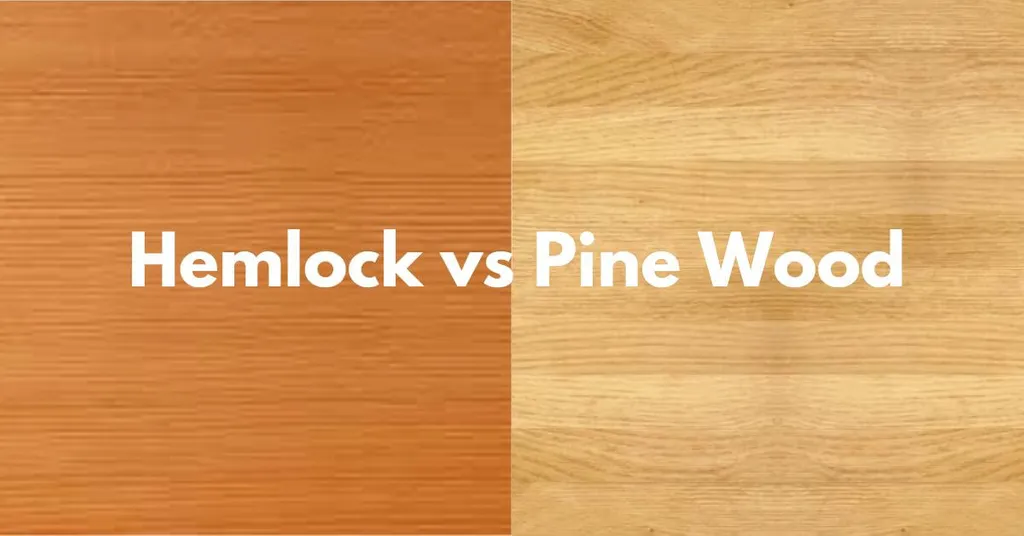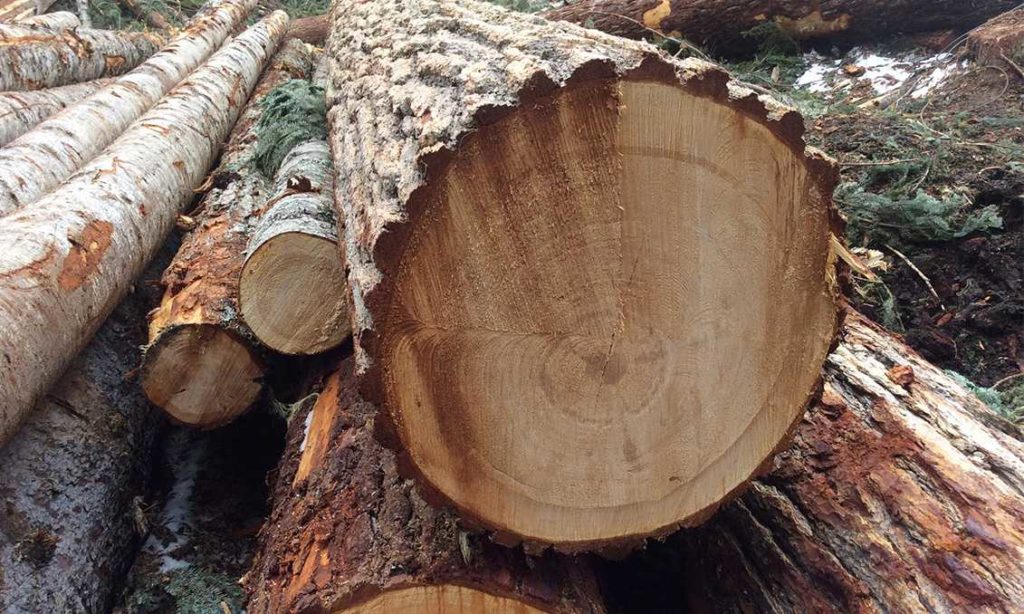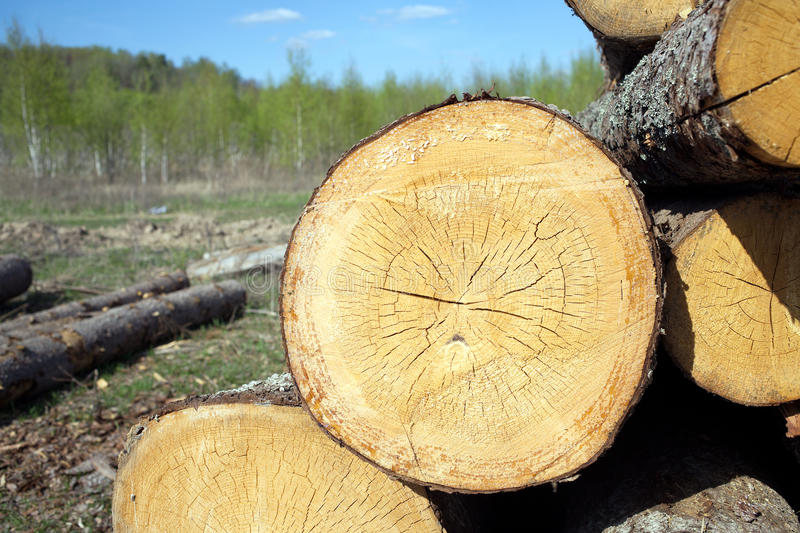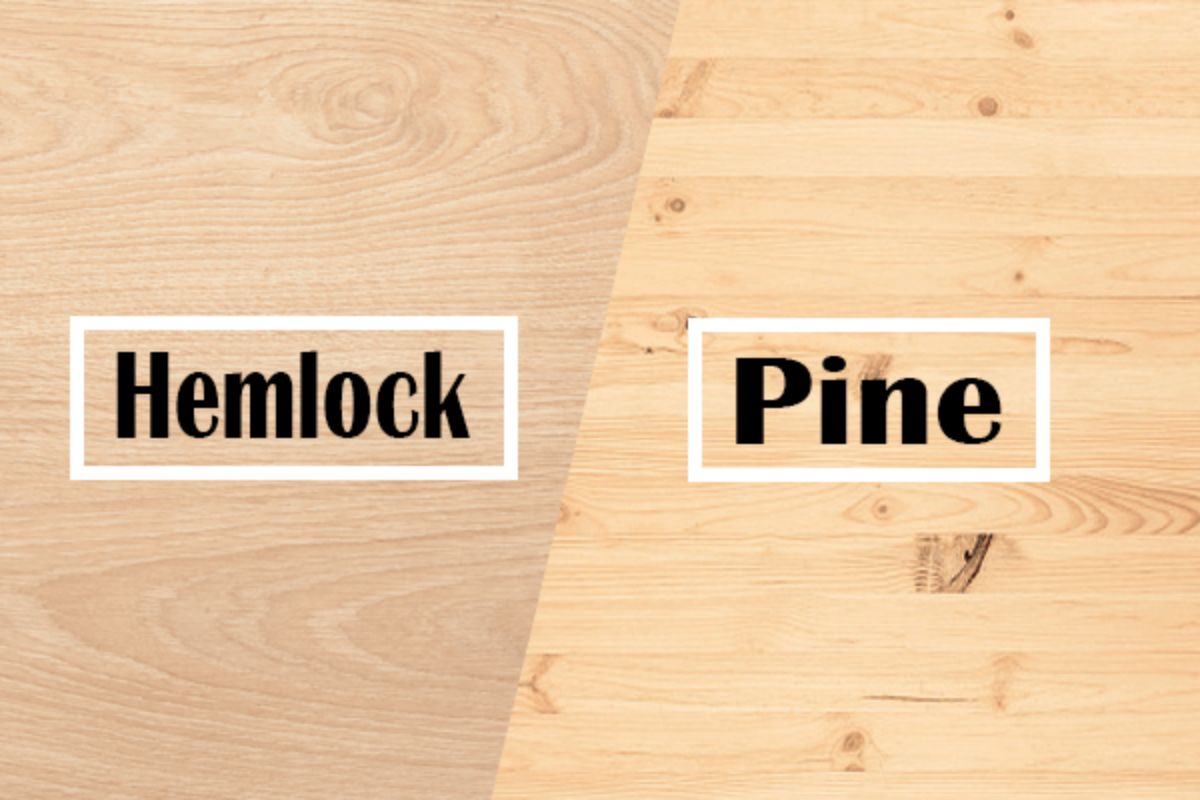When selecting the best wood for making furniture, general construction, and other wood projects, you may wonder which type of wood works best. Two popular kinds of wood are pine and hemlock wood; each one has its exceptional characteristics and impressive strength.
Let’s find out more about hemlock wood vs. pine wood and get to know the pros and cons of using these woods. Also, we’ll look into some of the most popular hemlock wood species as well as pine wood species. Learning all these can help you select the best wood for your projects.
Hemlock Wood vs. Pine Wood

At first glance, you would think that the two wood types look exactly the same because of their light colors but actually, they are not. Upon closer inspection, hemlock wood looks finer and has evenly distributed grains. Pine wood has many imperfections and irregularities. But these are just the outer appearance of hemlock and pine wood.
Both hemlock and pine wood belong to the pine family. Hemlock is also known as pine wood but with only a few knots. The Pinaceae or pine family also includes coniferous trees like spruce, pine, cedar, and hemlock trees.
The main characteristic of pine trees and shrubs is that these come with needle-like structures for leaves together with scales and grains. These pine trees can grow from 7 to 300 feet, most of which are lovely evergreen trees. There are around 115 species of trees that belong to the pine family.
Color
Hemlock wood has white to pale brown sapwood. This is the wood layer found in the outermost layers. The heartwood is the middle part of the wood, and hemlock wood has a pale yellow to light brown color heartwood.
Meanwhile, pine wood has a creamy white to yellowish sapwood. Heartwood colors range from light brown to reddish-brown. Therefore, if you want wood furniture with a more golden color, pine wood furniture is for you. But if you prefer darker wood, hemlock wood is the best for you.
Grain
The hemlock wood grain is straight, but you may also find spiral grains when you take a closer look. The pine wood grains are generally uneven. You’ll find all kinds of structures among the grains like stripes, waves, curls, and much more. You will instantly notice these imperfections even when viewing the wood from afar.
Texture
Hemlock wood looks delicate and smooth, but when you look closely, it has a coarse or uneven grain texture. Pine also has varying textures, which can be seen easily, even from a distance. Closely, you’ll see the significant imperfections along the grain.
Wood Density
Hemlock has a 41 to 50 pounds per cubic feet density, while pine has a 22 to 53 pounds per cubic feet density. This means that pine is slightly denser than hemlock. Density is an indicator of a wood’s strength. Thicker wood is stronger.
Workability
Hemlock wood glues well and accepts stains, and finishes nicely. However, Hemlock wood tends to develop splinters when it’s being worked, so be very careful. You must wear protective gloves and gear to keep your hands safe as you work with Hemlock wood.
This wood also takes a lot of time to dry. It’s best to closely follow instructions on how to use paints, finishes, and stains and to observe proper drying times.
When it comes to pine wood, many woodworkers and builders prefer to use pine wood because it’s one of the easiest to work with. This wood nails well, and handles finish well. One disadvantage of using pine wood is that it comes with many knots and imperfections, and thus it’s often hard to cut. To improve cutting, use a sharp power saw or a circular saw instead of a hand saw.
Strength
Hemlock wood has the upper hand when it comes to strength. Hemlock is stronger and a lot stiffer than pine, and thus, it is more preferred for construction work, furniture, and flooring. This wood is weighty and, at the same time, works great with hand and power tools. You can also expect Hemlock wood to last longer than pine for about 5 to 10 years as long as it is well-maintained.
Meanwhile, pine wood is solid and durable compared to other softwood species. It has a high bending strength and compressive strength. It may not be as strong and as durable as hemlock wood, but it is still the choice of many woodworkers for furniture and for building home structures and décor.
Durability
Durability is the measure of how long wood will last. You should select a durable type of wood for construction use and furniture making.
When it comes to durability, pine wood is more durable than hemlock wood. This is because hemlock is susceptible to rotting and decay. You cannot use hemlock to make outdoor furniture and other outdoor wooden structures. Hemlock will last only 5 to 10 years in excellent condition. But one good thing about Hemlock is that it can resist insect attacks, especially burrowing insects.
Pinewood is durable and can resist warping. This wood will never shrink and swell even when exposed to high moisture environments. It also resists moisture, but it’s not entirely resistant to rotting, but a pine growing for some time may develop resistance to rotting.
Cost
Pine wood is readily available because this tree grows quickly. Thus, pine wood is more affordable compared to other softwoods. And compared to hemlock wood, pine wood is cheaper, with a price ranging from $4.50 to $10 for every square foot. Hemlock is more expensive than pine, with a price ranging from $15 to $16 for every square foot.
Hemlock Wood Pros and Cons
Consider the following advantages and disadvantages of hemlock wood
Pros
- Hemlock wood is hard and durable. These qualities make this wood great for building roofing, sub-flooring, and framing.
- Hemlock wood will never warp and change shape compared to pine wood.
- Hemlock wood dries longer than other woods, but once it’s dry, it can hold paint very well.
- This wood has a very smooth texture, and thus it’s easy to stain and finish.
Cons
- Hemlock is easily affected by decay and rotting. This is why it’s not for building outdoor furniture.
- Hemlock is expensive compared to pine wood.
- Hemlock may produce dangerous chemicals when it’s being worked. These chemicals can cause allergies and breathing issues.
- Hemlock can cause small splinters, and thus, you need to wear protective gloves when working with this wood.
Pine Wood Pros and Cons
Consider the following advantages and disadvantages of pine wood
Pros
- Pine is a more affordable option than hemlock.
- Pine wood is light and thus easier to work with.
- Pine wood can resist swelling and shrinking.
- Pine wood has a lovely grain pattern. It is naturally charming, that many woodworkers and furniture makers love.
- Pine wood is excellent for making flooring as this can withstand high-traffic areas.
- Pine wood is excellent as a Christmas ornament or as a Christmas tree.
Cons
- Pine wood can be susceptible to denting and scratching.
- Pine wood can change color, especially when it is exposed to direct sunlight.
- Pine wood is not resistant to moisture and thus, needs regular care and proper storage.
- Pine wood has a lot of knots and swirls, making it harder to work with than hemlock.
Popular Hemlock Wood Species and Their Characteristics and Uses

There are many species of hemlock wood but let’s take a closer look at three of the top ones used in construction projects, such as plywood and other projects.
Eastern Hemlock (Tsuga Canadensis)
Eastern hemlock is used for lumber and for making ornaments. It has wider growth rings compared to the Western Hemlock, and currently, Eastern hemlock trees are being threatened by an insect called the hemlock woolly adelgid. This is a non-native pest that’s killing hemlock trees.
- Location: Eastern hemlock is mostly found in Eastern North America
- Tree Size: 62 to 100 feet tall and 2 to 3 feet wide
- Average Dried Weight: 28 pounds per cubic feet
- Specific Gravity: .36, .45
- Janka Hardness: 500 pounds-feet
- Appearance: The Eastern hemlock has a light red-brown heartwood with lighter sapwood but is indistinguishable from the heartwood. The growth rings have unique patterns and can only be appreciated when the wood is flat-sawn.
- Grain or Texture: this hemlock species has a straight grain but sometimes has interlocking and spirals. The texture is coarse and uneven. The end grain has no resin canals and has a moderate transition from early to latewood.
- Resistance to Rotting: Eastern hemlock is not durable to decay and is also susceptible to insect attacks and burrowing.
- Workability: Eastern hemlock will easily splinter when worked and is challenging to plane. Sanding is also tricky because it’s hard to tell the heartwood and sapwood apart. This species accepts glues, finishes, and stains well.
- Presence of Odor: Easter hemlock does not give off any odor even when worked.
- Availability: Eastern hemlock wood is harvested in North America together with Western Hemlock. This is mainly used as construction wood because it is abundant in the area. The price for this wood is moderate because it’s a domestic hardwood.
- Uses: Eastern hemlock is excellent for various construction projects, boxes, crates, frames, plywood, and many more.
Western Hemlock (Tsuga heterophylla)
Western hemlock is known as the biggest of all the hemlock trees, and thus, it is a valuable source of lumber exported from Canada. The Western hemlock tree is also the official state tree of Washington State.
- Location: Western hemlock trees are widely available on the northwest coast of North America
- Tree Size: 165 to 200 feet tall and 3 to 5 feet wide
- Average Dried Weight: 29 pounds per cubic feet
- Specific Gravity: .37, .47
- Janka Hardness: 540 pounds-feet
- Appearance: Western hemlock heartwood is light red-brown, and the sapwood is lighter than the heartwood. You cannot distinguish the sapwood from the heartwood of this hemlocks species. This wood has occasional dark streaks due to wood bark maggots attacks. Growth rings can be readily appreciated on a flatsawn wood surface.
- Grain or Texture: Western hemlock has a straight grain but an uneven and coarse texture. The end grain has absent resin canals and gradually transitions from early to latewood growth.
- Resistance to Rotting: Western hemlock is not resistant to decay and is also prone to insect burrowing or attacks.
- Workability: Western hemlock is easy to work with; however, the fact that you can’t tell between the heartwood and sapwood makes it harder for you to use this wood in some projects. This wood can take stains and finishes very well.
- Presence of Odor: Western hemlock does not emit any odor.
- Availability: Western hemlock is commonly used as construction material and is mainly combined with fir and other hemlock species to create “HEM-FIR.” The price of Western hemlock is moderate considering that it is domestic softwood.
- Uses: Western hemlock is also helpful as construction lumber, plywood, frames, pallets, boxes, and crates.
Mountain Hemlock (Tsuga mertensiana)
The mountain hemlock is a heavier and more durable hemlock species from North America. It is often compared to the Eastern hemlock because of its narrow growth rings or tightly-spaced rings. When it comes to physical appearance, the mountain hemlock is quite similar to the Western hemlock tree.
- Location: this hemlock species is distributed along the northwestern coast of North America
- Tree Size: 65 to 130 feet tall and 3 to 4 feet wide
- Average Dried Weight: 33 pounds per cubic feet
- Specific Gravity: .42, .53
- Janka Hardness: 680 pounds-feet
- Appearance: mountain hemlock has a light red-brown heartwood and lighter sapwood. Just like the Western hemlock, you cannot distinguish the sapwood from the tree’s heartwood. This wood has fine growth rings with unique grain patterns visible when the wood is flat-sawn.
- Grain or Texture: the mountain hemlock grain is straight but has coarse or uneven grain textures. The end grain has absent resin canals while there is a gradual change from early to latewood.
- Resistance to Rotting: mountain hemlock is not durable to rotting and decay. It is also easily affected by insects and pests.
- Workability: this hemlock species is easy to work with; however, the disparity between the earlywood and latewood affects its appearance causing uneven surfaces and dips. This wood works well with stains and glues.
- Presence of Odor: mountain hemlock does not have any odor.
- Availability: mountain hemlock is not as extensively harvested as the Western hemlock. This is used as construction wood so that prices can be moderate as domestic softwood species.
- Uses: mountain hemlock is commonly used for plywood, frames, crates, pallets, boxes, and construction purposes.
Popular Pine Wood Species and Their Characteristics and Uses

There are many types of pine trees, and a careful understanding of these wide varieties will help you find the right one to use for your projects. Take note that some pine tree species have similar characteristics, while there are also pine varieties with unique ones. Let us look at the soft pines and hard pines.
Soft Pines
Soft pines are wood with low densities, very even grains, and slow early to latewood changes. There are three subspecies of soft pines: Sugar Pine, Western White Pine, and Eastern White Pine. A fourth species is a Limber pine, but it is not as commonly used.
The Eastern White Pine has a unique texture because of its small resin canals. The Sugar Pine is coarse because of its large resin canals. The Western White Pine has characteristics that are between the Sugar Pine and Eastern White Pine.
Hard Pines
The characteristics of hard pines are entirely the opposite of soft pines. Hard pines grow quicker than soft pines and have uneven grains. There are several subgroups of hard pines: the southern yellow pines, western yellow pines, red pines, and Pinyon pines.
The following are descriptions of some of the most common pine species available.
Sugar Pine (Pinus lambertiana)
Sugar pine is the largest of the pine species growing more than 200 feet. Sugar Pine wood is also called soft pine.
- Location: Sugar pine is available in mountainous areas of the Pacific coasts of the United States.
- Tree Size: 130 to 200 feet tall and 3 to 5 feet wide
- Average Dried Weight: 25 pounds per cubic feet
- Specific Gravity: .34, .40
- Janka Hardness: 380 pounds-feet
- Appearance: sugar pine has a light brown to reddish heartwood with a pale yellow to white sapwood. There are apparent small brown stripes along flatsawn surfaces.
- Grain or Texture: the grain is even straight with a moderately-coarse texture. The end grain has large resin canals and as a slow early wot latewood transition periods.
- Resistance to Rotting: the Sugar Pine heartwood has low to medium resistance to rotting.
- Workability: This pine species is easy to work with using power and hand tools. This wood accepts finishes and glues every well.
- Presence of Odor: the Sugar pine has a slight sweet smell that’s noticeable when worked.
- Availability: Sugar pine is abundant in California. It is sold as pine but can be combined with other species and sold as domestic softwood.
- Uses: you can use sugar pine as lumber, millwork, boxes, crates, and musical instruments.
Western White Pine (Pinus monticola)
The Western White Pine is also known as Idaho White Pine. It is the state tree of Idaho State and is considered high-grade lumber with the stamp “IWP.”
- Location: Western White Pine is abundant in the mountainous areas of western North America
- Tree Size: 100 to 150 feet tall and 3 to 5 feet wide
- Average Dried Weight: 27 pounds per cubic feet
- Specific Gravity: .35, .43
- Janka Hardness: 420 pounds-feet
- Appearance: Western White Pine has a light brown to red heartwood and a pale yellow to white sapwood. You can expect this wood to darken as it ages.
- Grain or Texture: this pine species has a straight grain with a medium texture.
- Resistance to Rotting: the Western White Pine heartwood has low resistance to decay and rot
- Workability: This pine species is easy to work with whether you’re using power or hand tools. This also accepts glues and finishes very well.
- Presence of Odor: the Western White Pine has a slight resinous smell when the wood is being worked.
- Availability: this wood is harvested for its lumber to be used in construction. It has a moderate to high price for domestic softwood species.
- Uses: Western White Pine is most commonly used as construction lumber, veneer, crates, boxes, plywood, wooden matches, carving projects, and millwork.
Ponderosa Pine (Pinus ponderosa)
Pinus ponderosa is a hard yellow pine with many characteristics like soft white pines. It has a lower density than the yellow pines in the eastern United States.
- Location: Ponderosa pine is grown in Western North America
- Tree Size: 100 to 165 feet tall and 2 to 4 feet wide
- Average Dried Weight: 28 pounds per cubic feet
- Specific Gravity: .38, 45
- Janka Hardness: 460 pounds-feet
- Appearance: The Ponderosa pine has a red-brown heartwood and yellow-white sapwood.
- Grain or Texture: this pine species has straight grains with a medium texture. The endgrain comeswiht medium tolarge resin canals. This species has a quick early to latewood transition.
- Resistance to Rotting: Ponderosa pine has moderate to little resistance to rotting.
- Workability: this wood is easy to work with using hand and power tools. It also works well with glues and finishes.
- Presence of Odor: Ponderosa pine comes with a slight resinous smell when worked.
- Availability: Ponderosa pine is widely distributed in the western North America. It is also considered one of the essential lumber in the United States. This pine is mixed with other species like the Lodgepole Pine and is available as “PP/LP.”
- Uses: Ponderosa pine is used as construction wood, subflooring, plywood, veneer, posts, trims, cabinets, and sheathing.
Final Words
Choosing between hemlock and pine wood will depend on your project. You should consider the durability, workability, and cost of your wood materials and the pros and cons of using each type of wood. Understanding these qualities will help you find the most fitting and practical choice between hemlock and pine wood.

Leave a Reply